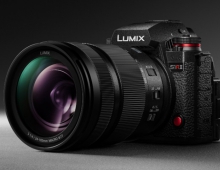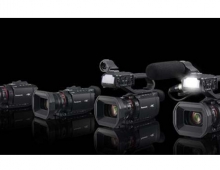
Panasonic Develops 60GHz Multi-Gigabit Wireless Circuit Technology for Mobile Devices
Panasonic has successfully developed a 60GHz multi-gigabit wireless communication technology that is optimized for mobile devices, and supports both the the WiGig specification and/or the IEEE802.11ad draft specification.
Wireless Gigabit Alliance was established by technology leaders to address the need for faster, wireless connectivity between computing, communications and entertainment devices. Panasonic has been a board member of WiGig Alliance.
The IEEE802.11 is a Working Group that defines a set of standards for Wireless Local Area Network. The Task Group IEEE802.11ad has developed a draft standard specification for next generation high speed communication of above 1Gbps in the 60GHz frequency band.
Panasonic's multi-gigabit wireless communication technology consists of a 60GHz transceiver and a baseband processor which are integrated individually onto CMOS semiconductor chips through circuit technologies optimized for mobile devices. The technology enables multi-gigabit wireless communication of more than 20 times faster than existing wireless LANs using the 60GHz frequency band, and through the optimization of both the transceiver core and peripheral circuits, it also enables lower than 1W low-power, multi-gigabit wireless communication in the future.
Up till today, only the 2.4GHz and 5GHz bands have been used in high-speed wireless communication for mobile devices while 60GHz ultra-high-speed wireless communication remains to be employed only in stationary devices such as TVs, but not in mobile devices due to the higher energy consumption associated with the use of wider frequency bandwidth.
With high-speed communication of 20 times faster than existing wireless LANs, this technology allows the transferring of a 30-minute long compressed high definition (HD) video content within 10 seconds. In combination with the low power features made possible through the transceiver core and peripheral circuits optimization, it has been made viable for mobile devices such as smart phones that requires lower than 1W of power consumption in their radio function unit.
The technology has the following features:
- Lowest noise signal generator (-95dBc/Hz at 1MHz offset frequency) enables high sensitivity wireless performance. The transceiver has been integrated into a CMOS chip, which leads to miniaturization of the mobile devices.
- Forward error correction (FEC) code is indispensable to maintain reliability in high-speed wireless communication. In this technology, the circuit size of decoding block is 30% smaller than that of Panasonic's conventional architectures by optimizing decoding circuits. This reduction results in lower power consumption.
- The chipset supports the WiGig specification, which is going to be an industry standard for a multi-gigabit, short range wireless communication system. It will provide reliable interoperability among various devices.
Panasonic's development will be presented at ICC 2011 (International Conference on Communications 2011) to be held at the Kyoto International Conference Hall, Japan from June 5 to 9, 2011.
This new technology was partly supported by "The research and development project for expansion of radio spectrum resources" of The Ministry of Internal Affairs and Communications, Japan.
The IEEE802.11 is a Working Group that defines a set of standards for Wireless Local Area Network. The Task Group IEEE802.11ad has developed a draft standard specification for next generation high speed communication of above 1Gbps in the 60GHz frequency band.
Panasonic's multi-gigabit wireless communication technology consists of a 60GHz transceiver and a baseband processor which are integrated individually onto CMOS semiconductor chips through circuit technologies optimized for mobile devices. The technology enables multi-gigabit wireless communication of more than 20 times faster than existing wireless LANs using the 60GHz frequency band, and through the optimization of both the transceiver core and peripheral circuits, it also enables lower than 1W low-power, multi-gigabit wireless communication in the future.
Up till today, only the 2.4GHz and 5GHz bands have been used in high-speed wireless communication for mobile devices while 60GHz ultra-high-speed wireless communication remains to be employed only in stationary devices such as TVs, but not in mobile devices due to the higher energy consumption associated with the use of wider frequency bandwidth.
With high-speed communication of 20 times faster than existing wireless LANs, this technology allows the transferring of a 30-minute long compressed high definition (HD) video content within 10 seconds. In combination with the low power features made possible through the transceiver core and peripheral circuits optimization, it has been made viable for mobile devices such as smart phones that requires lower than 1W of power consumption in their radio function unit.
The technology has the following features:
- Lowest noise signal generator (-95dBc/Hz at 1MHz offset frequency) enables high sensitivity wireless performance. The transceiver has been integrated into a CMOS chip, which leads to miniaturization of the mobile devices.
- Forward error correction (FEC) code is indispensable to maintain reliability in high-speed wireless communication. In this technology, the circuit size of decoding block is 30% smaller than that of Panasonic's conventional architectures by optimizing decoding circuits. This reduction results in lower power consumption.
- The chipset supports the WiGig specification, which is going to be an industry standard for a multi-gigabit, short range wireless communication system. It will provide reliable interoperability among various devices.
Panasonic's development will be presented at ICC 2011 (International Conference on Communications 2011) to be held at the Kyoto International Conference Hall, Japan from June 5 to 9, 2011.
This new technology was partly supported by "The research and development project for expansion of radio spectrum resources" of The Ministry of Internal Affairs and Communications, Japan.




















